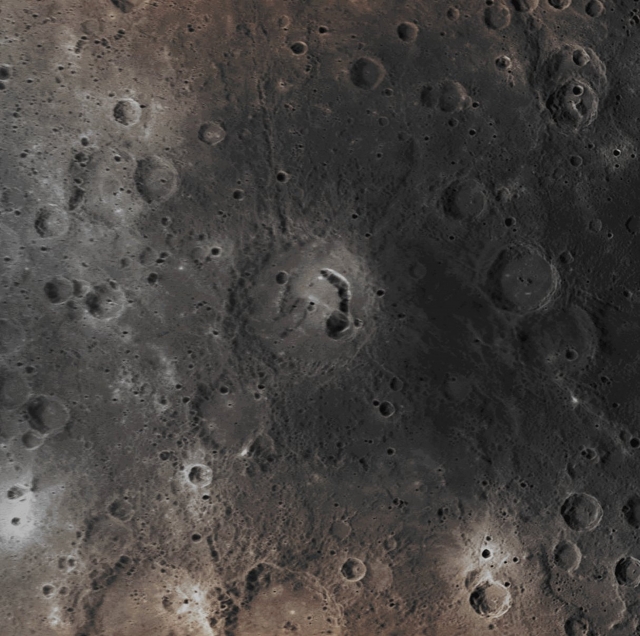
June 27, 2012
Credits: NASA/Johns Hopkins University Applied Physics Laboratory/Carnegie Institution of Washington and Dr Paolo C. Fienga/LXTT/IPF for the additional process. and color.
|
The Impact Crater pictured in the center of today's APOD has been recently named Picasso, in honor of the Spanish painter and sculptor Pablo Picasso (1881-1973). This Impact Crater, first imaged during the NASA - MESSENGER Spacecraft's 3rd (third) Fly-By of the Planet Mercury has drawn a certain scientific attention on to itself because of the large and arc-shaped Pit-Chain located on the Eastern Side of its Floor. Similar Pits have been discovered on the Floors of several other Mercurian Craters, such as Beckett and Gibran, and the most reliable Theory about how these Pits might have formed says that their creation could have occurred when a significant quantity of Subterranean Magma (such as Magma which did not erupt nor, even - maybe - quietly, surfaced in any way) either subsided, or drained, causing the Surface above it to collapse into the resulting void. If this interpretation is basically correct, Collapse Pit Chains - such as this one at Picasso Crater - provide us with evidence of a so-called shallow Magmatic Activity which must have happened sometimes in the History of Mercury. Date of Acquisition: September 29, 2009 Instrument: Narrow Angle Camera (NAC) of the Mercury Dual Imaging System (MDIS) Resolution: 500 meters/pixel (0,31 miles/pixel) Scale: the diameter of Picasso Crater is roughly 133 Km (such as approx. 83 miles) Projection: this image is a portion of the NAC approach mosaic from Mercury Fly-By n. 3, and it is shown in a simple Cylindrical Map Projection. This frame has been colorized in Absolute Natural Colors (such as the colors that a human eye would actually perceive if someone were onboard the NASA - MESSENGER Spacecraft and then looked down, towards the Surface of Mercury), by using an original technique created - and, in time, dramatically improved - by the Lunar Explorer Italia Team. |
News visualized: 575 times

